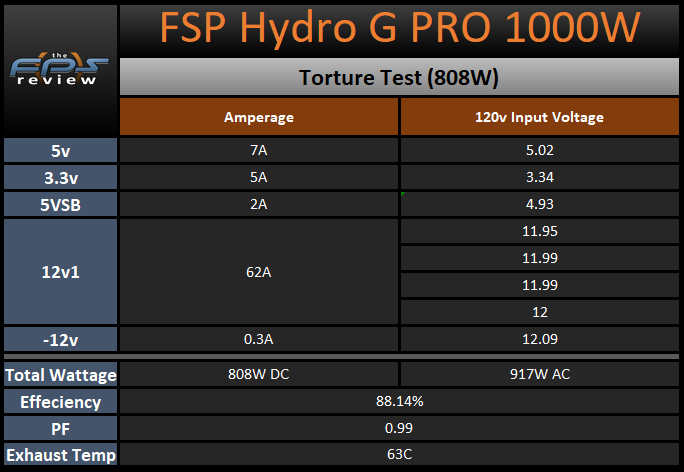Load Testing
For those of you that are curious as to some of the reasoning and equipment behind our PSU testing program here at TheFPSReview, we have put together an introduction for you. This program is based on what the author developed at [H]ardOCP and utilizes the equipment bequeathed to the author by Kyle Bennett. The testing we are conducting today is exactly as described in that document and start with our 120v, 100v, Torture, and 80 Plus Tests.
120v and 100v Load Testing Results

Test #1 is equal to approximately 25% of the rated capacity of the FSP Hydro G PRO 1000W at 45c. This makes Test #1 equal to 268W by loading the 12v rail to 20a, the 5v rail to 2a, the 3.3v rail to 1a, the +5vsb to 2a, and the -12v to 0.3a. The results of Test #1 show all of the positive DC output rails starting off above nominal. The efficiency for this unit is starting off in excellent shape with a value of 92.12% at 120v AC input and 90.56% at 100v AC input. We see the exhaust temperature is 48C at 120v AC input and 49C at 100V AC input.
Test #2 is equal to approximately 50% of the rated capacity of the FSP Hydro G PRO 1000W at 45c. This makes Test #2 equal to 492W by loading the 12v rail to 38a, the 5v rail to 3a, the 3.3v rail to 2a, the +5vsb to 2a, and the -12v to 0.3a. Test #2 sees across the board declines in DC output voltages relative to what we saw with Test #1. The largest changes are 0.02v on the main DC output voltages. The +5vsb saw a 0.07v decline as well. The efficiency has moved down to 91.52% at 120v AC input and 90.18% at 100v AC input. We see an exhaust temperature of 52C at 120v AC input and 54C at 100V AC input.
Test #3 is equal to approximately 75% of the rated capacity of FSP Hydro G PRO 1000W at 45c. This makes Test #3 equal to 745W by loading the 12v rail to 58a, the 5v rail to 5a, the 3.3v rail to 4a, the +5vsb to 2a, and the -12v to 0.3a. Test #3 sees decreases in our output voltages once more. The 5v and 3.3v rails have dropped by 0.02v (5v) or 0.01v (3.3v). The 12v rail has dropped by up to 0.04v (depending on the connector). The efficiency in Test #3 moves down to 89.11% at 120v AC input and 87.44% at 100v AC input. We see an exhaust temperature of 54C at 120v AC input and 57C at 100V AC input.
Test #4 is equal to approximately 100% of the rated capacity of the FSP Hydro G PRO 1000W at 45c. This makes Test #4 equal to 997W by loading the 12v rail to 80a, the 5v rail to 4a, the 3.3v rail to 2a, the +5vsb to 2a, and the -12v to 0.3a. In the final regular test, we see the 12v output drop by up to 0.04v. The minor rails, however, see a decrease of just 0.01v each. The efficiency has dropped as we see it come in at 85.91% at 120v AC input and 83.75% at 100v AC input. We see an exhaust temperature of 56C at 120v AC input and 59C at 100V AC input.
Torture Test

The Torture Test is equal to approximately 80% of the rated capacity of the FSP Hydro G PRO 1000W at 45C. This makes the Torture Test equal to 808W by loading the 12v rail to 62a, the 5v rail to 7a, the 3.3v rail to 5a, the +5vsb to 2a, and the -12v to 0.3a. At the end of the Torture Test, the Hydro G PRO 1000W is still doing an excellent job. The DC output voltages are generally in line with what we have been seeing in the 120v load tests. The efficiency is good once more as we see a value of 88.14% and the exhaust temperature is 63C.
Load Testing Summary
Today, the Hydro G PRO 1000W proved to be a very good power supply when it came to the load testing. When we look at the voltage regulation, we see that the Hydro G PRO 1000W had peak changes of 0.1v on the 12v rail, 0.05v on the 5v rail, and 0.04v on the 3.3v rail. That said, these results seem to be very good given the absolute values we see. In relative terms, the only other 1000W unit we have reviewed, to date, is the SilverStone ST1000-PTS which this unit does better than.
When we look at the efficiency side of things, we see that the Hydro G PRO 1000W ranged from 85.19% to 92.12% efficient at 120v AC input and 83.75% to 90.56% efficient at 100v AC input which is very good. On that same note, this unit fell a bit short of the SilverStone ST1000-PTS in this regard (though this is to be expected given the two different segments they exist in). Lastly, the exhaust temperature peaked at 56C at 120v AC input, 59C at 100v AC input, and 67C during the Torture Test. With very good starting results in today’s testing, let’s move on to the Transient Load Tests.
